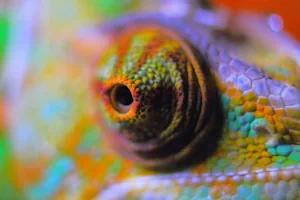Reptiles need UVB radiation to ensure healthy development, especially in relation to Vitamin D3 synthesis. Vitamin D3 is crucial for calcium absorption and bone health in reptiles. Without sufficient UVB radiation, reptiles can suffer from rickets or other calcium deficiency diseases.
Types of UV Radiation Important for Reptiles
There are two main types of UV radiation that are important for reptiles:
UVA Radiation
- UVA rays are important for the behavioral regulation and social behavior of reptiles.
- They contribute to stimulation and color perception but are not directly responsible for Vitamin D3 synthesis.
- UVA is also utilized for hunting and territorial behavior.
UVB Radiation
- UVB rays are the crucial radiation for the synthesis of Vitamin D3 in the skin of reptiles.
- Vitamin D3 helps with calcium absorption in the body, which is essential for building strong bones and maintaining metabolism.
- UVB radiation is necessary for reptiles to regulate their calcium metabolism, which is especially important for:
- The growth of young reptiles
- Reproduction in adult reptiles
Different UVB Requirements Depending on Species
Different species of reptiles have varying needs for UVB radiation, depending on their natural habitat:
Desert-Dwelling Species (e.g., Bearded Dragons, Leopard Geckos, Uromastyx)
- These reptiles need high UVB exposure as they live in areas where UVB radiation is intense and direct.
- A strong UVB source is required, often in the form of:
- Specialized UVB fluorescent tubes
- Metal halide lamps
Rainforest-Dwelling Species (e.g., Tree Chameleons, Geckos from Wetter Regions)
- These reptiles need moderate UVB exposure as they live in areas where UVB radiation is filtered through the canopy.
- For them, UVB lamps with lower wattages or less intense UVB radiation are better suited.
Aquatic Turtles
- These also require UVB radiation, but often at a lower intensity than desert dwellers, especially during the dry season when they spend time on land.
UVB Lamps and Lighting
Since natural UVB radiation, particularly indoors, is insufficient, it’s important to use specialized UVB fluorescent tubes or UVB lamps. These lamps simulate natural sunlight and provide reptiles with the UVB radiation they need.
- UVB fluorescent tubes are a common choice and should be placed at the correct distance from the reptile, depending on the specific UVB intensity of the lamp.
- These lamps should be replaced every 6-12 months as UVB emissions decrease over time.
- Metal halide lamps also provide UVB and can be used for larger reptiles, depending on the size of the terrarium.
Conclusion
Reptiles need UVB radiation for Vitamin D3 synthesis, which is essential for calcium absorption and bone health. UVB radiation is particularly important for reptiles that live in the sun, such as desert dwellers. UVA radiation is important for behavioral regulation but not for calcium metabolism. Make sure to choose the right type and intensity of UVB lamp for your reptile species to support their health.

